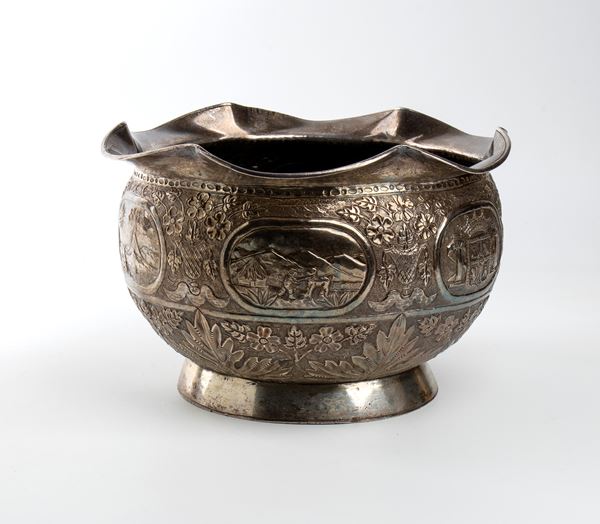274
Spanish solid silver bowl, First half of the 19th century
Height x diameter: 14.5 x 22 cm. Weight: 1252 g
circular shaped with moulded rim, resting on an annular foot, richly embossed and chiseled from a sheet with vegetal and floral motives; on the body, within oval reserves, the coat of arms of the Kingdom of Spain "Flag of the maritime plazas, castles, and forts defending the coasts of Spanish territories between 1701 and 1771 and in 1793", and scenes depicting the eruption of the Santa Catalina volcano in Lanzarote in 1730.
Apparently not marked; on the bottom, the engraved inscription "Porcile".
Literature:
The eruption of the Santa Catalina volcano in Lanzarote, which occurred in 1730, is recounted in the diary of the priest of Yaiza, Andrés Lorenzo Curbelo, who provides one of the main historical testimonies of this event, offering a detailed chronicle of it. In his account, the priest describes how, in a short time, a series of tremors opened a fissure in the ground near the village of Timanfaya, giving rise to a volcano. The lava began to flow rapidly, devastating the surrounding villages and forcing the inhabitants to flee for safety. The diary concludes with the cessation of the eruptions in 1736.
The eruption of the Santa Catalina volcano in Lanzarote, which occurred in 1730, is recounted in the diary of the priest of Yaiza, Andrés Lorenzo Curbelo, who provides one of the main historical testimonies of this event, offering a detailed chronicle of it. In his account, the priest describes how, in a short time, a series of tremors opened a fissure in the ground near the village of Timanfaya, giving rise to a volcano. The lava began to flow rapidly, devastating the surrounding villages and forcing the inhabitants to flee for safety. The diary concludes with the cessation of the eruptions in 1736.
Live auction 327
Curiosities from European and Oriental Art
Curiosities from European and Oriental Art
Silvers, Ivories, Corals, Icons and Wunderkammer
Palazzo Caetani Lovatelli, tue 25 February 2025
FIRST SESSION
25/02/2025 Hours 12:00 pm
Lots 1/167
SECOND SESSION
25/02/2025 Hours 04:00 pm
Lots 168/346




















